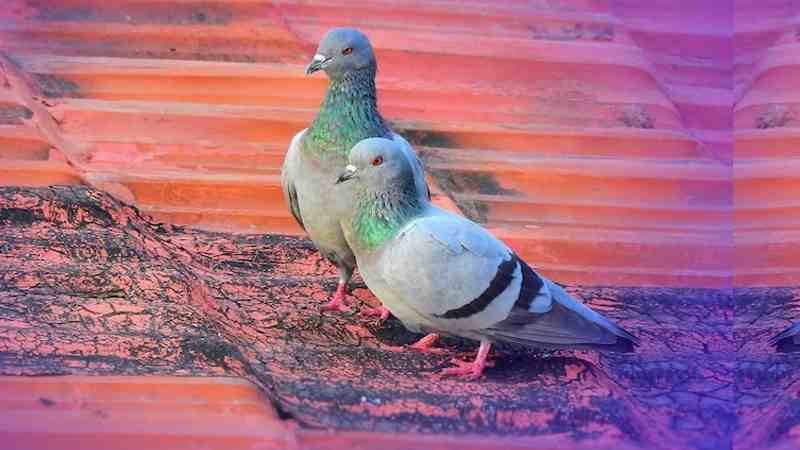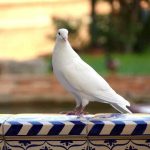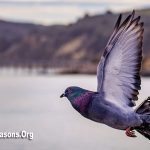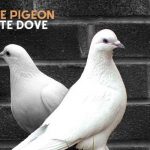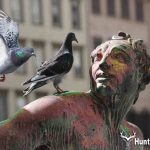Pigeon sitting reveals a simple behavior – the birds are relaxing, not exhibiting any kind of strange phenomenon. When sitting, they are likely feeling calm, conserving energy, and taking in their surroundings. Their posture and habits have logical explanations.
Why Do Pigeons Sit So Often?
They have several key reasons for these:
- Resting – They need to conserve energy between flights. It allows them to rest their wing muscles.
- Perching – It like to observe their surroundings from an elevated perch. Sitting on rooftops, ledges, statue heads, etc. gives them a good vantage point.
- Socializing – They are highly social and often sit together in flocks. Sitting in groups helps them bond and exchange information.
- Regulating Body Heat – By sitting with their feathers fluffed and legs pulled in, they can retain body heat in cool weather.
- Staying Alert – With their legs relaxed and ready, they can take flight quickly when needed. The sitting posture keeps them alert.
Common Pigeon Sitting Behaviors
Roof
Pigeons like to sit on rooftops and other elevated urban structures. This gives them good visibility of potential food sources and threats. They can also sun themselves on warm roofs and stay sheltered from wind and rain under overhangs.
Ledge
Ledges, window sills, and any narrow surfaces make ideal pigeon perches. Their grippy toes allow them to balance comfortably on very small spaces. Ledges provide a place to socialize and scope out the area below.
Statue
Statues and monuments with heads and shoulders are favorite pigeon sitting spots. These structures are elevated and mimic perfect perches. They likely see statue sitting as no different than on a branch.
Food
It may sit right on their food, either to warm it with their body heat or guard it from other birds. Sitting on food also allows them to eat slowly and digest properly.
Splay-Legged
They often sit with legs splayed sideways. This helps them stay balanced, regulate heat through their undersides, and get ready to take flight.
Pigeon Sitting Pictures Gallery
Photo credit unsplash.com
The Meaning Behind Various Poses
| Sitting Pose | Likely Meaning |
|---|---|
| With feathers fluffed | Conserving warmth on a cold day |
| Head tucked in | Sleeping/napping |
| Upright and alert | Keeping watch for threats |
| Facing into wind | Using body to block wind |
| Wings stretched | Letting sunlight reach skin for warmth |
| Huddled in group | Social bonding and sharing warmth |
Why Pigeon Sitting Is Normal Behavior
Though ubiquitous, pigeon sitting and roosting habits all have logical purposes for the birds. Next time you see this bird resting in groups or lined up on a roof, appreciate their normal behavior. Consider tossing them some bird seed to reward their natural vigilance as city dwellers.
FAQ
Why do pigeons bob their heads when they walk?
They bob their heads for better depth perception. Their eyes are positioned on the sides of their heads, so they bob to gain different perspectives and judge distances accurately. The head bobbing allows them to navigate safely when walking and landing.
Do pigeons sleep when sitting?
Yes, pigeons can and do sleep while sitting. They often nap while perched by tucking their head into their body and fluffing up feathers to retain warmth. They may also sleep in groups, taking turns keeping watch for predators. Unihemispheric slow-wave sleep allows them to sleep with one eye open.
Why do some pigeons spin in circles while sitting?
These birds sometimes spin in circles while sitting during courtship rituals. Males often display this dance-like behavior when pursuing a mate. The spinning shows off their flying abilities. Females may also spin to signal interest or reject the male’s advance.
How long can pigeons sit without moving?
They can remain remarkably still while sitting for long periods. During nesting, parent pigeons may sit for an hour or more to incubate eggs. Even when not nesting, it can sit motionlessly for 30 minutes or longer while roosting or resting. Their muscular legs allow them to maintain these stationary poses.
Do pigeons sit in a certain direction?
Pigeons typically face into the wind when sitting exposed. By positioning their bodies against the breeze, they can conserve warmth and reduce wind chill. Given a choice, it also prefer to sit facing walls or corners rather than wide open spaces, as they offer more cover.
- 2024 Washington Hunting Season New Dates & Regulation! - July 27, 2024
- Virginia Hunting Seasons 2024 Latest Dates & Regulations - July 22, 2024
- Georgia Hunting Season 2024-2025 [Updated Schedule!] - July 19, 2024

